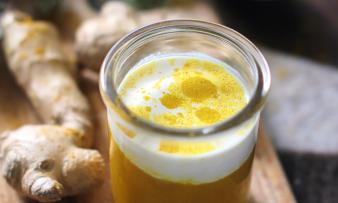Table of contents
Sunflower oil ( sunflower seed oil), made from the peeled seeds of the sunflower ( Helianthus annuus ), contains a high proportion of linoleic acid ( LA, omega-6 fatty acid).
Use in the kitchen
Sunflower oil, actually sunflower seed oil, is very popular due to its mild taste.
Cold-pressed oil has a yellowish color and tastes a little nuttier than refined sunflower oil. It refines raw dishes such as salads, dressings or sauces. It can occasionally be used for gently sautéing (e.g. vegetables), but it is not suitable for high temperatures.
Refined sunflower oil tastes more neutral, is lighter, almost colorless and can be heated up to about 180 °C. However, there is a risk of trans fats. Because of its yellow color, it is valued for the production of margarine or mayonnaise. Sunflower oil is also often found in industrially produced baby food.
Which sunflower oil should you use for frying? There are so-called "high oleic" sunflower varieties. Due to special breeding processes, these varieties produce very heat-stable oils. Such HO oils can also be used for frying or deep-frying (up to 210 °C).
Sunflower oil has an unfavorable fatty acid profile. For health reasons, it is better to use refined rapeseed oil for cooking and cold-pressed rapeseed oil, linseed oil or walnut oil for cold dishes. It is better to use oil-free salad dressing with apple cider vinegar, lemon juice, mustard and spices. Or you can try the oil-free vinaigrette with walnuts or the salad dressing with avocado .
Vegan recipe for vinaigrette with sunflower oil
Ingredients: 4 tablespoons white balsamic vinegar, 4 tablespoons orange juice, 1 tablespoon mustard ,black pepper, 3 tablespoons sunflower oil, 1 small onion .
Preparation: Mix the vinegar, orange juice, mustard and pepper well in a bowl with a whisk. Then slowly add the oil while stirring constantly. This way the ingredients combine to form a creamy, homogenous sauce. Peel a small onion, chop finely and add to the vinaigrette. The vinaigrette goes well with green or mixed raw vegetable salads.
Vegan recipes with sunflower oil can be found under the note: " Recipes that have the most of this ingredient ".
| Not only vegans or vegetarians should read this: Vegans often eat unhealthily. Avoidable nutritional errors . |
Purchasing - Storage
Refined sunflower oil can be found in all supermarket chains such as Coop, Migros, Denner, Volg, Spar, Aldi, Lidl, Rewe, Edeka, Billa and Hofer .
Since the refining process is not required to be labeled, it is better to assume that oils without the designations "cold-pressed" or "virgin" have been refined. 11 Refined sunflower oil is light yellow or almost colorless.
Selected organic supermarkets ( Alnatura or Denn's Biomarkt ), health food stores and drugstores also stock cold-pressed sunflower oil from organic production all year round . Cold-pressed sunflower oil is often also called "native".
Organic oil is never refined, only deodorization (removal of odors and flavors) is partially permitted. However, many organic associations view this process critically and therefore prohibit it. Cold-pressed oil is made from unpeeled, germinable seeds; some perceive it as bitter, tart or even rancid. 2 However, "rancidity" means that the oil has experienced too much oxidation in the air or has been exposed to water.
The availability of sunflower oil varies depending on the size of the store, catchment area, etc. Our recorded food prices for the DA-CH countries can be found above under the ingredient image - and by clicking you can see their development at various suppliers.
Cold-pressed oils (laws, raw food)
In Switzerland, oil is referred to as cold-pressed oil if the oilseed was not heated, the pressing temperature did not exceed 50 °C and no problematic post-treatment took place.
According to the Federal Department of Home Affairs ( FDHA ), an edible oil is considered to be cold-pressed (or may be described with synonyms such as (extra) virgin, unrefined, cold-pressed or natural) if it is obtained by pressing or centrifuging from previously unheated raw materials, the temperature during pressing did not exceed 50 °C and there was no refining, i.e. no neutralisation, no treatment with adsorbents, bleaching earth and no steaming .
An oil may be labelled as “gently steamed” if the refining process was limited to steaming and did not exceed 130 °C . 22
In the EU and the USA, there does not appear to be a generally applicable temperature limit set by law for cold-pressed oils. For example, the guidelines for edible fats and oils of the Federal Ministry of Food and Agriculture (D) are similar to the EDI regulation, but they do not specify a permissible maximum temperature for general cold pressing - since they only apply to products whose labelling and composition are not conclusively set by law (i.e. not for olive oil, cocoa butter, milk fats, spreadable fats). 23
However, both the EU directives and the amendment to the EDI regulation on edible oil provide for special rules for the labelling of olive oils . 24,25
These are selective marketing rules in which the term raw food is not defined. "Raw food" and "raw" are therefore not state-protected terms (as is the case with the term "organic"), which leaves a lot of room for interpretation. Although it is agreed that with purely mechanical cold pressing, the pressing temperatures generally do not exceed 40 °C, one should not naively assume that cooking oils are raw food quality. There is a suspicion that the measuring method used does not indicate the temperature in the press cylinder (where the heat is highest), but only the outlet temperature in the oil hose. With water-cooled olive oil presses (so-called "water-cooled 37°" oil presses), one probably cannot even say with certainty what the exact temperature is inside the press cylinder, because the entire press cylinder is surrounded by cooling sleeves.
In addition, the pressing pressure and speed as well as the moisture content of the oilseed affect the pressing temperature. If, for example, the moisture content is too low, the temperature rises during pressing and it is difficult to stay even below the maximum limit of 50 °C. 26
Storage tips
Sunflower oil is sensitive to heat, light, water, atmospheric oxygen and foreign odors. Because of its high content of polyunsaturated fatty acids, it should be stored in a cool, dark place and in containers that are as completely filled as possible. The less oil there is in the container, the more atmospheric oxygen comes into contact with the sunflower oil and leads to faster spoilage through oxidation. Opened sunflower oil should be stored in the refrigerator and used up within four to eight weeks. 3
Originally sealed containers can be stored for about two years (see best-before date).
Ingredients - Nutritional values - Calories
Sunflower oil has 884 kcal/100g, which come exclusively from fat. The proportion of saturated fats is about 10%. The ratio between the two unsaturated fats linoleic acid (LA) and alpha-linolenic acid (ALA) is 616:1. 5
Sunflower oil is particularly notable for its vitamin E content (41 mg/100g). Hemp oil and hazelnut oil have a similar value (41 mg and 47 mg respectively), while truffle oil has a slightly higher content (62 mg). 5
It also contains a little vitamin K (5.4 µg/100g). This corresponds to only 7% of the daily requirement for 100 ml. So it is negligible for a portion of 1 tablespoon. Rapeseed oil has 71 µg/100g, which is many times more vitamin K. Green vegetables and salads are particularly rich in vitamin K, for example chard (830 µg/100g), kale (705 µg/100g) and spinach (483 µg/100g). 5
The complete ingredients of sunflower oil, the coverage of the daily requirement and comparison values with other ingredients can be found in our nutrient tables. In the article Nutrients explained you will get a detailed insight into the topic.
Effects on health
Is sunflower oil healthy? The most important criteria for assessing an oil as "healthy" or "unhealthy" are the content of unsaturated fatty acids and the ratio of omega-6 to omega-3 fatty acids. Sunflower oil has a high content of unsaturated fatty acids, but the LA:ALA ratio is very poor . The proportion of inflammation-promoting omega-6 fatty acids (linoleic acid, LA) is particularly high and it contains practically no omega-3 fatty acids (alpha-linoleic acid ALA). Linoleic acid forms arachidonic acid (ARA), which is converted into hormone-like eicosanoids that have an inflammation-promoting and vasoconstricting effect, promote arteriosclerosis and the sensation of pain. Alpha-linoleic acid forms eicosapentaenoic acid (EPA) and docosahexanoic acid (DHA), which form eicosanoids that have anti-inflammatory, antithrombotic and bronchodilator and vasodilator effects. Since both conversion processes use the same enzymes, they compete with each other. 12 According to Dr. Michael Greger, the ideal omega-6 to omega-3 ratio is 1:1 in order to maintain a balance between the two conversion processes in the body. The guidelines of the Federal Nutrition Commission (EEK) are less strict and recommend reducing the ratio to at least 5:1. 9 Therefore, instead of sunflower oil, you should use linseed oil, walnut oil and cold-pressed rapeseed oil for cold dishes and refined rapeseed oil for frying and cooking, which have a good omega-6 to omega-3 ratio.
It is even healthier not to consume oil, but to eat seeds and nuts instead. All oils are concentrated foods that have been through various processing steps. In general, whole, unprocessed foods such as nuts or seeds are preferable. Various American doctors, including heart specialists, take an even stricter approach, rejecting oil on principle and recommending switching to nuts and seeds. We are talking about Dean Ornish, T. Colin Campbell, John A. McDougall, Michael Klaper, Caldwell Esselstyn, Michael Greger, Joel Fuhrman and Neal D. Barnard, who basically explain that a diet high in animal fats and proteins (like the standard American diet) is bad for your health.
Regardless of whether you look at the ratio or the absolute numbers: Due to excessive use of cooking oils, vegans and vegetarians in particular get too many omega-6 fatty acids. The ratio is usually between 14:1 and 20:1, or even higher. 27 You can find details in the text " Vegans often eat unhealthily. Avoidable nutritional errors ". Health-conscious people get polyunsaturated fatty acids from linseed, chia seeds, walnuts (tree nuts), macadamia, herbs and leafy vegetables because they have a particularly good ratio between LA and ALA. You can find detailed tables for practically all foods under the ingredients, which can also be accessed from the recipe. The recipes also summarize this. Erb-Müesli, for example, has the ideal composition, with a LA-ALA ratio of 1:1.
There are studies that show that sunflower oil has a positive effect on health. For example, animal models have shown that monounsaturated oleic acid reduces insulin resistance and can reduce dysfunction in fatty tissue despite obesity. However, natural sunflower oil contains only 19.5% monounsaturated oleic acid (18:1), almonds and almond milk contain 31%, rapeseed oil contains between 60 and 70%, and safflower oil contains 74%. 6 Another study found that people with dyslipidemia had a reduction in blood cholesterol levels when they regularly consumed sunflower oil. Rapeseed oil has the same effect. 10 However, unlike sunflower oil, rapeseed oil has a good fatty acid profile. Therefore, these 'positive' studies do not justify the consumption of sunflower oil.
Secondary plant substances
Many of the health effects of sunflower oil can be attributed to the secondary plant substances it contains. Our article on secondary plant substances provides an overview of the classification of substance groups, their occurrence in foods and possible effects on humans.
However, it should be noted that the composition of secondary plant substances in sunflower seeds and products made from them can vary depending on the variety, time of harvest, growing conditions, recipe and manufacturing process. Therefore, quantities are only of limited use and should only be understood roughly.
Dangers - Intolerances - Side effects
All refined vegetable oils contain 3-MCPD fatty acid esters, which the International Agency for Research on Cancer ( IARC ) classified as a "possible human carcinogen" in 2011. The highest levels are found in highly refined vegetable oils and vegetable fats. Some of them are also hardened (e.g. margarine). Grape seed oil and especially walnut oil showed higher levels than the other oils, probably due to the roasting that takes place before production. Infant milk powder also showed higher levels of fatty acid esters, as they contain refined fats and oils. The last step in refining, deodorization, leads in most cases to the development of 3-MCPD esters. In some cases they can also form during steam treatment. Animal fats such as butter, lard, etc. do not contain 3-MCPD esters, as they are not normally refined. 11.30
Sunflower oil contains only a few trans fatty acids. 13 Certain food technology processes can convert natural cis configurations of unsaturated fatty acids into trans configurations. Trans fatty acids can cause lipid metabolism disorders or promote coronary heart disease. Hydrogenation can change the texture and stability of oils and harden them. For example, unsaturated fatty acids are converted into saturated ones to make margarine. 12
Sunflower seeds are a rare source of allergy. Although sunflower oil is considered safe for patients with food allergies because it contains virtually no proteins, numerous exceptions have been confirmed. 14
Folk medicine - natural healing
What is sunflower oil good for? Sunflower oil is used for aching limbs by massaging the oil in. It is also used to treat wounds that are slow to heal. Internally, the oil is said to have a laxative effect. 15
Sunflower oil is sometimes used for oil pulling treatments (also called oil treatments, oil sucking or oil chewing). Oil pulling is known in Indian and Russian folk medicine. Sesame oil is usually used for study purposes, which has shown significant effects against Streptococcus mutans and Lactobacillus acidophilus . Oil pulling is said to have a detoxifying effect. The process is also said to prevent pathogens from settling in the mouth and throat. Oil pulling is also said to have a positive effect against rheumatism, stomach and intestinal problems. 7 However, existing studies on dental health are inadequate, which is why the effect of oil pulling on dental health remains unclear. Studies on the detoxifying effect (detox) are not available. 8
Sunflower petals are used in folk medicine. As a tincture or tea, they are said to have an anti-fever effect. 15
Ecological footprint - animal welfare
The CO 2 footprint is primarily used to assess the climate friendliness of a food. This depends on various aspects such as cultivation method (conventional/organic), seasonality, country of origin, processing, transport and, if applicable, packaging. Carbon Cloud gives a value of 2.49 kg CO 2 eq/kg for Swiss sunflower oil. 1 The Danish climate database Concito gives 3.71 kg CO 2 eq/kg. 21
The water consumption of refined sunflower oil is on average 6792 l/kg. In comparison, rapeseed oil has 4301 l/kg, palm oil 4971 l/kg, linseed oil 9415 l/kg, olive oil 14,431 l/kg and sesame oil 21,793 l/kg. 4
For detailed explanations of various sustainability indicators (such as ecological footprint, CO2 footprint, water footprint), see our article: What does the ecological footprint mean?
Animal protection - species protection
Sunflowers, with their large basket flowers, are an ideal source of pollen and food for bees, insects and birds. Grown in small gardens, meadows or as flowering areas, they help protect species.
Worldwide occurrence - cultivation
Sunflowers originally come from North and Central America. Archaeological finds show that sunflowers were domesticated in the Mississippi region and in Mexico around 2500 BC. In the 16th century, Spanish sailors brought sunflower seeds to Europe. 16,27
In 2020, around 20.5 million tonnes of sunflower oil were produced worldwide. This put sunflower oil in fourth place behind rapeseed oil (25.18 million tonnes), soybean oil (59 million tonnes) and palm oil (76 million tonnes). The main producers of sunflower oil in 2020 were Ukraine (6.1 million tonnes), Russia (6.0 million tonnes) and Turkey (1.1 million tonnes). 17
Cultivation - Harvest
Sunflowers have a strong stem that is alternate, with heart-shaped, triangular, rough, hairy leaves. The annual Asteraceae can grow up to a height of 3 m. 18 The flowering period is from July to September. The diameter of the flower heads can be up to 35 cm.
The fat content of the seeds varies greatly depending on the variety. 15 Oil-rich varieties are used to produce sunflower oil. High-oleic sunflowers (HO) are sunflowers that have been bred (not genetically modified!) to have an oleic acid content of 75 to 93%. Normal varieties have between 14 and 39.4% oleic acid. 20 The high proportion of monounsaturated fatty acids (oleic acid) also increases the heat and oxidation stability of the oil. These are usually small and have a deep black seed shell. 27,28
The mechanical harvest takes place when the seeds are ripe. With an average annual grain yield of around 2.5 t/ha, around 10 t of harvest residues (straw) remain in the field. 19
Genetically modified sunflowers are controversial; they are said to be resistant to drought, heat, insecticides, herbicides and plant diseases. Such plants have been approved for cultivation in Canada, for example. 2
Wild
sunflowers ( Helianthus annuus ) can be found on compost heaps, on rubble weed beds and on the edges of paths and roads. 15
Possibility of confusion
As it belongs to the same genus, Helianthus annuus looks very similar to Helianthus tuberosus when it is in bloom. However, it is not the oil-containing seeds of this plant that are used, but rather the inulin-containing tuber. It is known commercially as Jerusalem artichoke .
Industrial production
There are two processes for producing sunflower oil, hard pressing and solvent extraction. Until 1940, hard pressing was the most important method. To extract the oil, the processed sunflower seeds are pressed under high pressure. Around 25% of the oil can be extracted this way. In solvent extraction in the pre-pressing process, medium pressure is applied to the processed sunflower seeds, followed by solvent extraction to separate additional oil. In modern plants, 40% of the oil can be extracted from the seeds in this way. Due to the better economic efficiency of solvent extraction, this is now the most common process for producing sunflower oil worldwide. 29
The oil is then refined. Refining refers to various "refinement processes" to ensure better purity and a long shelf life, but at the expense of valuable ingredients. Bleaching, for example, leads to the removal of beta-carotenes (secondary plant substances). 29
Organically certified oil must not be refined - in some cases, deodorization (removal of odors and flavors by steaming) is permitted.
Although the yield is greater with refined products, ingredients, secondary plant substances and polyunsaturated fatty acids suffer from this process.
Further information
The sunflower ( Helianthus annuus ) belongs to the genus of sunflowers (Helianthus) within the daisy family (Asteraceae). A characteristic feature of sunflowers is their ability to turn their heads towards the sun (heliotropism).
Alternative names
Common names for the sunflower are: God's eye, gold flower, sun crown, sun star. 15
The drug name for sunflower petals is Helianthi flos, and sunflower oil is Helianthi oleum.
In English, sunflower oil is called sunflower oil.
Other uses
Sunflower oil is not only used in cooking as cooking oil, but also in the production of lubricants, cosmetics, paints and varnishes, pharmaceutical products and biodiesel. Press residues and defatted meal are approved for animal feed.
Bibliography - 29 Sources (Link to the evidence)
| 1. | Carbon Cloud. Sunflower Oil, Switzerland. 2024. |
| 2. | Pini U. Das Bio-Food Handbuch. Ullmann: Hamburg, Potsdam. 2014. |
| 3. | Bundeszentrum für Ernährung. Lebensmittellagerung im Haushalt (PDF). |
| 4. | Mekonnen MM, Hoekstra AY. The green, blue and grey water footprint of crops and derived crop products. Hydrol. Earth Syst. Sci. 2011;15:1577-1600. |
| 5. | USDA United States Department of Agriculture. |
| 6. | Finucane OM, Lyons CL et al. Monounsaturated Fatty Acid-Enriched High-Fat Diets Impede Adipose NLRP3 Inflammasome-Mediated IL-1β Secretion and Insulin Resistance Despite Obesity. Diabetes. 2015;64(6):2116-2128. |
| 7. | Fleischhauer SG, Guthmann J, Spiegelberger R. Enzyklopädie Essbare Wildpflanzen. AT Verlag: Aarau. 2013. |
| 8. | Kerschner B. Ölziehen: fettreiche Zahnhygiene ohne Wirknachweis. Medzin Transparent. 2020. |
| 9. | Schweizerische Eidgenossenschaft EKK Eidgenössische Ernährungskommission. Fette in der Ernährung. 2006. |
| 10. | Saedi S, Noroozi M et al. How canola and sunflower oils affect lipid profile and antrhopometric parameters of participants with dyslipidemia. Med J Islam Repub Iran. 2017;31(5). |
| 11. | CVUA Stuttgart Chemisches und Veterinäruntersuchungsamt Stuttgart. 3-MCPD-Ester in raffinierten Speisefetten und Speiseölen - ein neu erkanntes, weltweites Problem. 2007. |
| 12. | Biesalski HK, Bischoff SC, Pirlich M et al. Ernährungsmedizin. 5. Auflage. Thieme: Stuttgart, New York. 2018. |
| 13. | Tasan M, Demirci M. Trans FA in Sunflower Oil at Different Steps of Refining. Journal of the American Oil Chemists'Society. 2003;80:825-828. |
| 14. | Ukleja-Sokolowska N, Gawronska-Ukleja E et al. Sunflower seed allergy. Int J immunopathol Parmacol. 2016 Sep;29(3):498-503. |
| 15. | Pahlow M. Das grosse Buch der Heilpflanzen. Gesund durch die Heilkräfte der Natur. Nikol: Hamburg. 2013. |
| 16. | Adeleke BS, Babalola OO. Oilseed crop sunflower (Helianthus annuus) as a source of food: Nutritional and health benefits. Food Sci Nutr. 2020;8(9):4666-4684. |
| 17. | FAO Food and Agriculture Organization of the United Nations. Crops and livestock products. Production Quantity 2020. |
| 18. | Schilling E. Helianthus Linnaeus. Helianthus annuus. Flora of North America North of Mexico. Oxford University Press: New York, Oxford. 2006;21. |
| 19. | Kaltschmitt M et al. Energie aus Biomasse. Grundlagen, Techniken und Verfahren. Springer: Berlin. 2009. |
| 20. | Bundesministerium für Ernährung, Landwirtschaft und Verbraucherschutz. Deutsches Lebensmittelbuch. Leitsätze für Speisefette und Speiseöle. 2008 |
| 21. | The Big Climate Database Concito. Sunflower oil. 2024. |
| 22. | Eidgenössisches Departement des Innern. Verordnung des EDI über Speiseöl, Speisefett und daraus hergestellte Erzeugnisse vom 23. November 2005 (Stand am 9. April 2015). |
| 23. | Bundesministerium für Ernährung und Landwirtschaft. Leitsätze für Speisefette und Speiseöle. Neufassung vom 02.07.2020 (BAnz AT 18.08.2020 B3, GMBl 2020 S. 530). |
| 24. | Amtsblatt der Europäischen Union. Durchführungsverordnung (EU) Nr. 29/2012 der Kommission vom 13. Januar 2012 mit Vermarktungsvorschriften für Olivenöl. Artikel 5 a) und b). |
| 25. | Verordnung des EDI über Speiseöl, Speisefett und daraus hergestellte Erzeugnisse. Änderung vom 25. November 2013. Art. 2b. |
| 26. | Schaufler D. Oilseed Fact Sheet: Oilseed Presses. Dept. of Agricultural and Biological Engineering, Penn State College of Agricultural Sciences. |
| 27. | Lentz DL, DeLand Pohl M et al. Sunflower (Helianthus annus L.) as a pre-Columbian domesticate in Mexico. PNAS. 2008;105(17):6232-6237. |
| 28. | Khurana S, Singh R. Sunflower (Helianthus annuus) Seed. In: Tanwar B., Goyal A. (Eds.). Oilseeds: Health Attributes and Food Applications. Springer: 2021; 123-143. |
| 29. | Martínez-Force E, Turgut Dunford N, Salas JJ (Ed.) Sunflower. Chemistry, Production, Processing, and Utilization. 2015;187-226, 227-2258. |











Comments